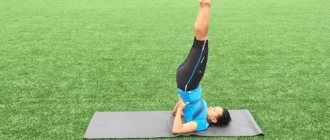Fewer sets with heavier weights is a strength-training way to train. More approaches with lighter weights - training according to the mass program. How to determine what is better, what training will be more effective? How many repetitions should you do in a set? In fact, both methods should be used in your training process, since using both will allow you to work your muscles comprehensively. The whole point here lies in the characteristics of the muscles, or more precisely, muscle fibers, which work differently depending on the duration of the load.
Muscle fibers are divided into fast (white) and slow (red). Slow-twitch muscle fibers are trained best by volume-mass training, but fast-twitch muscle fibers are trained best by intense strength training. Why is that? The thing is that, depending on the intensity and duration of the loads in the body, certain muscle fibers will be involved.
Slow muscle fibers
Red fibers, on the contrary, are intended for prolonged loads. These are slow-twitch fibers that are characterized by low strength, but low fatigue and are able to accumulate and store energy, and then gradually expend it.
Our task is to work on both those fibers and others. In this case, the result will be higher than if you pay attention only to weight training. Yes, strength training does not pump well the slow muscle fibers, which provide the bulk of muscle mass, but you will gain weight anyway. It is impossible to increase strength without increasing mass. At the same time, by developing fast muscle fibers, you thereby increase strength indicators and it will be easier for you to progress by training according to programs for gaining muscle mass.
Find your own balance
Regardless of your main goal, it is recommended to periodically change the intensity of the training process.
Photo: istockphoto.com
Here are some examples of how this can be implemented:
During one workout.
You can do heavy weight squats for 2-6 reps. Then dumbbell press. Afterwards you can do push-ups on the uneven bars 6–12 times. Another exercise would be dumbbell flyes – 15–20 repetitions.
By splits.
On the first and second days, pay attention to strength training. In this case, the upper part of the body is worked out first, and the lower part the next day. The third and fourth training days should be reserved for volumetric exercises.
According to training cycles.
This complex involves two weeks of training for strength, then two to increase volume and another two to develop endurance.
Number of repetitions at different degrees of preparation
If you are new to the gym, then you should first accustom your body to the load. The nervous system must adapt to the stress and learn to cope with it correctly. The general recommendation in this case would be to perform an average of 3-5 sets with light weights and 12 to 15 repetitions.
When the initial level has already been completed and some experience has already been gained, you should move on to heavier training with fewer repetitions, but with an increased number of approaches. Your muscles will sooner or later get used to and adapt to the loads and to stimulate them you will need to lift working weights. The general recommendation for advanced athletes is to perform a large number of sets of 4 to 6, not counting warm-ups, with reps ranging from 6 to 8.
The goal is to increase strength
Many people go to gyms to get stronger. However, for this it is not enough to have bulky muscles.
Muscles are made up of so-called muscle fibers. And during work, not all of these fibers are tensed at the same time, which directly affects strength. To increase it, you need to train in such a way that when muscles contract, the maximum number of fibers is activated.
Photo: istockphoto.com
To develop strength, you can perform exercises with heavy weights, but with only 2-5 repetitions per set. Moreover, the weight must be selected so that it reaches up to 95% of your one-repetition maximum.
Although such training is considered optimal for the development of strength qualities, it is not recommended to abuse them. This is especially true for exercises that involve many muscles and joints, such as the bench press or the clean and jerk.
The fact is that such training tires the central nervous system. Therefore, the recovery will be quite long, and due to accumulating fatigue, the athlete may get injured. Experts advise diluting your workouts with exercises with light weights, which will have a positive effect on the muscles and nervous system.
Number of repetitions for different training goals
- To develop strength, perform up to 8 repetitions
- To build mass, perform 8 to 12 repetitions
- To develop endurance, perform 12 repetitions or more
When planning your training process, do not try to find some kind of universal solution for all occasions. Explore, experiment, change training programs, use different approaches. Train for strength, for mass, work on each type of muscle fiber, this will give a total effect and the result will not be long in coming.
The goal is to become healthier and more resilient
Athletes who go to the gym to improve their health and improve their endurance levels should lift light weights. Up to 50% of the maximum weight you can lift once will be sufficient. But there should be more repetitions - about 15 times.
Photo: istockphoto.com
Such classes are perfect for beginners, people aged or after injuries. Also, such a training process is considered optimal for athletes who return to strength exercises after a long break.
Exercises with light weights are much safer for the spine and joints. In addition, the risk of injury is reduced.
By performing up to 25 repetitions in each approach, you develop endurance. In addition, such training improves intermuscular coordination, which allows you to use your muscles more efficiently.
Breakthroughs in sports science that will help you train effectively
Some people believe that exercising with light weights cannot increase muscle size. This is a misconception. With multiple repetitions, muscle mass increases, as with exercises with heavy weights. However, there are several nuances.
Working weight calculator
Friends, by popular demand, I finally made various fitness calculators on my blog, including a cool working weight calculator that will help you easily choose your working weight for an exercise.
In fact, the working weight calculator on my blog is extremely intuitive and simple, just enter your data and get an answer regarding your specific working weight:
Well, don’t forget to write your opinion in the comments about the article, the calculator, and generally about how you are doing, I’m very interested in communicating with you!
How many repetitions and approaches should I do?
Let's now talk in more detail about each case of performing an approach to mass, strength, endurance or relief, but before that, let's introduce the concepts of basic terms .
Repetition (repetition) is the execution of a movement alternately in two opposite directions, that is, first in the phase of eccentric contraction (the muscle lengthens), and then in the phase of concentric contraction (shortening the muscle). And if it’s very simple, then a repetition is a one-time exercise, that is, one time .
An approach is performing without rest (without stopping) several repetitions in a row (from one and above).
How many repetitions and approaches to do
Set time is the time it takes to complete repetitions in one set.
For strength (increasing strength indicators)
One of the main tasks and goals of many athletes in various sports is to increase strength indicators, which are often the prevailing factor in victory in speed-strength sports. For example, if you are a sprinter , then strength indicators are more important to you, and if you are a stayer , then endurance, based on this you need to build your training process.
In bodybuilding , approaches to increase muscle mass also increase strength, but not at all as pronounced as if you were performing an approach with an emphasis on increasing strength indicators.
Training for strength means performing an exercise for a small number of repetitions from 1 to 5 times , in this given number of repetitions the muscles will be under load for about 2-25 seconds , which means active consumption of creatine (remember the energy supply of muscle activity) and training of fast muscle fibers (myofibrillar hypertrophy).
Accordingly, the more intense the training, the more and faster creatine is consumed in the body. That is why if your goal is to increase strength, then it is advisable to combine your training with taking creatine supplements.
Perform strength approaches
Creatine is a natural compound formed in the body from three amino acids (methionine, arginine and glycine), which is involved in energy metabolism and is consumed in large quantities during active physical work for a maximum of the first 2 minutes , then other energy sources (glycogen, fats) are connected.
Thus, strength training - with a small number of repetitions in approaches, actively stimulates the growth of contractile proteins (the main ones are myosin, actin, actomyosin, tropomyosin, troponin, b- and b-actinins)
When training, it is important to select such a weight on the bar/simulator so that you enter a given range of the number of repetitions, in this case from one to five, that is, after the fifth repetition you should experience failure (or almost muscle failure). If, for example, you did 5 repetitions and finished the set, but you yourself feel that you could still do 3-4 repetitions from above, then increase the working weight - you should have enough strength for clearly 5 repetitions (or less if you do 2 -4). Otherwise, your training cannot be considered full-fledged for strength, but rather for mass with an underload .
For mass (increasing muscle volume)
Approaches performed for mass in bodybuilding must lie strictly within the range
8-12 reps , which corresponds to approximately 80% of your maximum weight lifted in the exercise. It is with this type of training that strength exercises can bring you significant success in hypertrophy (increase) muscle mass.
8-12 rep sets are very popular in gyms among bodybuilders, and for good reason. A very long time ago, when experiments had not yet been carried out on the effectiveness of one or another training option, bodybuilders found out empirically that the 8-12 repetition range grows muscles very well (for example, remember the words of Tom Platz, who, responding at his seminar , said that many things in He learned about bodybuilding through experience, and only then read studies that confirmed his effective training). This happened with the number of repetitions, Tom Platz came to the conclusion: 8-12 repetitions best increase muscle mass, but only later these data were confirmed by scientists (link to one of the studies in 2008 https://physoc.onlinelibrary.wiley.com /doi/full/10.1113/jphysiol.2008.164483, which states that protein synthesis in the body occurs most actively when an athlete trains with 80% of his maximum working weights, which equals 8-12 repetitions of the exercises.)
So, it is worth keeping in mind that if strength training increases the amount of contractile protein, then mass training increases the amount of non-contractile protein, that is, increased time under physical activity activates sarcoplasmic hypertrophy.
Thus, performing the exercise 8-12 times (average number of repetitions) maintains a balance between sarcoplasmic and myofibrillar hypertrophy, which has the best effect on increasing muscle mass, that is, this training option is ideal for bodybuilders.
Performing approaches to increase muscle mass
The optimal time during which a strength (anaerobic) exercise is performed in one approach to weight will be 30-60 seconds .
In addition, do not forget that when an athlete trains for weight, the most important supplement for him will be not only creatine, but also protein - the use of high-quality amino acids, which can be taken, for example, from whey protein .
For relief (increasing muscle dryness)
Before moving on to the description of training principles for muscle relief, I would like to tell you that dryness and its separation are determined not by training at all, but by the percentage of fat in the body. Therefore, as you probably already guessed, the less fat you have, the more prominent you will look and it doesn’t matter at all what kind of training you do.
to nutrition alone , you just need to know that proper nutrition is the most important factor when it comes to muscle definition. In addition, you can, of course, lose weight on a diet , but without training you won’t even muscle tone . Therefore, it is important to choose the right training option based on your current physique. Accordingly, it will be much easier mesomorphs for endomorphs .
So, for example, if you already have impressive amounts of muscle mass, and just want to dry out your muscles, then we recommend that, firstly, shift your diet towards a calorie deficit , and secondly, include cardio training , which will not only make it more effective burn fat, but also strengthen the cardiovascular system. If you are obese and suddenly want to dry out your muscles, then any training will be of little effectiveness, in this case you need to urgently change your diet and in every possible way speed up your metabolism by including only aerobic exercises .
Performing muscle relief approaches
And now that you already know the intricacies of muscle relief, you can move on to describing the construction of training principles for drying muscles.
How to structure your workouts and how many repetitions to do to tone your muscles?
Once you have decided on your body type and current physical fitness, you can move on to choosing workouts:
- Standard strength training + cardio + diet changes
- High-intensity training with low rest and high repetitions + changing the menu towards a calorie deficit + aerobic (cardio) exercise
As mentioned above, for more effective fat burning , we recommend that you include aerobic exercises (running, jumping, jumping rope, exercise bike, etc.) in your training program and naturally reduce calorie intake, mainly by giving up fast carbohydrates (flour, sweets, soda , white rice, fast food, chips, etc.). For those interested, we discussed nutritional options for drying muscles in detail in this article.
The number of repetitions, in the first option (when we don’t change strength training), we keep the training at 8-12 = the optimal range for maximum muscle growth, but at the same time we definitely reduce the calorie intake (cut carbohydrates, add proteins) and add cardio training , for example, three running workouts of 40 -50 minutes at a pulse of 120-130 beats .
How much does it cost to train for muscle definition?
In the second training option, we bring the repetition range to 15 , and the number of approaches to 5-6 , thereby we force the muscles to work as energetically as possible, and accordingly, fat “burns” faster. However, we do not recommend performing more than 15 repetitions on relief, since in this case muscle hypertrophy , that is, the more repetitions you do, the less weight you will have to put on the bar/simulator, which means the muscles will receive less load . and as you already know, the range of 8-12 maximizes muscle growth, so the further we move away from it, the worse it is for muscle hypertrophy.
In addition, you must remember that it is impossible to dry muscles and increase their size at the same time. Yes, of course, during training and after it, the processes of catabolism (destruction) and anabolism (growth) of muscle mass are constantly going on, and when the second process wins, we can talk about hypertrophy, and when it loses to the first process (catabolism), we talk about muscle destruction /fat. Everything would be fine if the processes of anabolism were not associated with weight gain , and naturally, along with muscles, a person will gain fat (of course, it can be minimized, but it will be gained), so the most correct decision will be for all “jocks” who want to have large, defined muscles - first gain weight, and then dry it out, with the help of:
- high intensity strength training
- cardio exercises
- proper nutrition (creating a calorie deficit)
Without these three components (especially the last two!) in your training process, no matter how many repetitions you do in the exercises, you will not see sculpted muscles.
Cardio for muscle relief
Thus, if you want to quickly lose weight despite significant muscle loss, then choose high-intensity exercises, cardio and a calorie deficit; if maintaining muscle mass is important to you, then choose slow, gradual fat burning through moderate strength training (we accelerate the metabolism ), cardio and calorie deficit. That is, between the first and second options there will be a fundamental difference in the intensity and choice of exercises performed (in the first case there are more high-intensity, high-repetition exercises with a range of 10-15 repetitions and involving cardio, in the second case there are more basic strength exercises with a range of 8-12 repetitions) .
For muscle endurance
The number of repetitions in endurance exercises should be many (15-20) , in addition, we must not forget that endurance varies, it is one thing when we are talking about strength endurance, another thing when it comes to monotonous, high-intensity aerobic exercise (long-distance swimming , long distance running, cross country and so on).
In this article we will dwell in detail on speed-strength endurance, because this is what most often interests athletes who visit the gym.
To put it very simply, strength endurance is the ability to perform intense work (show great strength) for a long time. For example, a sprinter in running or swimming will train sprinting qualities by constructing his training program in a certain way to develop speed-strength endurance; in bodybuilding pump approaches (performing a large number of repetitions with a small weight) .
As you already know from our other articles, the main supplier of ATP (energy) in the gym during exercise is creatine in the form of creatine phosphate and glycogen , and so thanks to biochemical reactions during the breakdown of creatine phosphate and carbohydrates (in the form of glycogen) along the path of anaerobic glycolysis (without participation of oxygen with the release of lactate) energy is produced. Moreover, the slower the consumption of creatine and glycogen and the faster the utilization of lactic acid (lactate), the more enduring the athlete will be; in addition, we must not forget that endurance training actively trains red, slow muscle fibers, which also thicken over time, actively growing capillary network, increase the number of mitochondria , as well as the ability to store glycogen, all this ultimately leads to the so-called sarcoplasmic hypertrophy of muscle fiber.
Circuit training to develop endurance
The best option for developing speed-strength endurance is still considered to be circuit training options , which involve performing a large number of repetitions and approaches with a short rest interval.
For example, a typical circuit training:
- pull-ups on the bar 30 sec.
- barbell squats 30 sec.
- biceps curl 30 sec.
- bench press 45 sec.
- static hold of the barbell while lying on a bench (pull your arms to your chest) for 30 sec.
The working weight in the approaches should be below average , approximately 50-60% of the maximum, the number of repetitions you perform in one session is as many . As soon as you finish the first circle, rest for 2-3 minutes, start the second, and so on up to 5 circles .
Strength exercises can be replaced with aerobic , then you will already be training aerobic endurance, something that is so necessary for many wrestlers, swimmers, boxers, and so on.
You may be interested, but each new kilogram of muscle mass requires additional oxygen (on average 0.2-0.3 l/minute), therefore, other things being equal, those who have less muscle will have more endurance.
Biceps training program with dumbbells
Since the biceps brachii muscles are small muscles, as well as synergists of the back muscles, it is not worth performing a large set of exercises on one muscle. To work out the biceps, 2-3 exercises are enough.
Biceps are not developed in a separate workout; they are always accompanied by either triceps or back muscles. Biceps can also be included in circuit training for the whole body, but in this case, just one exercise is enough.
Biceps and triceps workout with dumbbells
Triceps:
- French press with dumbbells.
- Extension with one dumbbell from behind the head.
- Bent over arm extension with one dumbbell.
Biceps:
- Seated arm curl with dumbbells with supination.
- Hammer grip curl.
- One-arm curl on a Scott bench.
Key points
- Studies of various populations have shown that muscle growth is possible over a very wide repetition range.
- If the protocols are similar in the number of sets, even with significant differences in training volume, they will lead to similar muscle gains.
- However, gains in muscle strength and endurance are closely tied to the rep range used.
- At least when it comes to training to increase muscle size, it's more helpful to think of training volume as the total number of heavy sets per muscle, rather than a "sets X reps X load" formula.
Greg's note:
“I am glad that Nathan wrote this article on a topic that we have been discussing for a long time, and this article is very much in line with my thoughts on the subject. There are a few downsides to the way people typically calculate training volume (sets X reps X load):
- inherently heavy exercises appear to be preferable to lighter ones (you can accumulate more volume in leg presses than in squats, and more in squats than in front squats);
- training with a lower percentage of your 1RM will almost always outperform training with a higher percentage (3 x 10 with a compound load implies much higher volume than 3 x 3 with a compound load).
Simply counting heavy sets is a much easier way to achieve the same goal without overly favoring certain exercises or loading patterns than other methods. For strength + size it is simply a matter of the number of heavy (80-85%+) sets performed, for strength + muscle endurance it is the number of relatively easy (≤65%) sets performed, for a combination of these areas it is simply a matter of the number of heavy sets performed in "intermediate intensity range."
Nathan Jones
Denial of responsibility.
I want to start this article with a disclaimer. Everything I have written on the topic is a picture that I have personally observed in the current literature on strength training and in the real world of strength training. However, I am by no means the most knowledgeable person when it comes to physiology or interpreting research, nor am I as strong or experienced as many competitive strength athletes. The pattern I noticed is also somewhat different from what many very educated people in the world of power probably observe, so perhaps I'm wrong about that. I do not believe that only I could write this article: it is presumptuous not to have some doubts. What follows is probably best viewed as a utility model with possible shortcomings.
Why is it important to perform a strictly prescribed number of repetitions/sets?
You should already understand that the main reason why a systematic, structured approach to your training is important is to obtain adequate training stress (undertraining is bad and too much physical activity is also bad).
One way to regulate training stress is to perform exercises for a given number of sets and repetitions with a certain amount of rest time between sets.
Athletes experimentally tested, and then scientists have proven, that different numbers of repetitions and approaches have different effects on increasing muscle mass, strength and endurance.
So, for example, in the industry of bodybuilding, powerlifting , and indeed in other strength sports, it is generally accepted that the number of repetitions performed is:
- 1-5 – for strength development
- 6-12 – volume of muscle mass
- 8-15 – muscle relief
- 12-20 – muscle endurance
The importance of performing a strictly designated number of repetitions in the approaches
In addition, these data are almost completely confirmed experimentally: scientific studies on various groups of people with different levels of training, one of them: Campos GE, Luecke TJ, Wendeln HK, Toma K, Hagerman FC, Murray TF, Ragg KE, Ratamess NA, Kraemer WJ, Staron RS. Muscular adaptations in response to three different resistance-training regimens: specificity of repetition maximum training zones. Eur J Appl Physiol. 2002;88:50-60.
Comparison of methods
First of all, decide what you want to get out of your sports training. For beginners, it’s best to start with low reps and light/medium weights:
- All types of training programs promote muscle growth. They just do it in different ways. So you need to add exercises from all speed types to your training system and alternate them;
- Don't jump straight into high-repetition programs (especially if you're trying to burn fat reserves). First, you will overload your body, which will shock your muscles, your internal organs and your health. Secondly, strength training will not help you get rid of extra pounds. Only a combination of the right diet and cardio training will help burn fat deposits and give you the desired relief.
How to alternate between high and low repetitions
There are two most optimal, proven and effective ways of alternating two styles of training:
- According to microcycles - a week of strength (low-repetition) style, the next week - high-repetition style;
- By cycle - change the system and type of training every 8-10 weeks.
In the first case, you can avoid muscle adaptation over a long period of time by simply changing training styles (as well as the order of exercises, technique, etc.) from week to week. In the second case, the distinct advantage will be the ability to track the progress of an entire block, ultimately choosing those loads that give the maximum response.
Main conclusions
So what does this all mean? I believe that based on the identified features, several general principles can be derived:
- Based on the size principle, we know that to recruit and fatigue all fibers, sets must be high force. We don't know the exact threshold of effort needed to stimulate hypertrophy, and there are plenty of people who experience significant muscle growth without doing anything to failure, but generally it's necessary to include sets of multiple repetitions to fatigue.
- For hypertrophy, rep range doesn't matter (at least up to 30 reps for trained people and 100 for untrained older people, as long as the tension in the set is similar. Muscles grow the same whether you lift the weight to failure of 3 or for 100 reps. It remains to be seen whether muscle growth will be similar if the groups are matched to 70% effort rather than to failure, but I believe it will be.
- Strength increases very specifically to the rep range used. If you need to improve your one-time max, you need to lift weights close to this value. If you want to improve your performance at high reps, you need to lift light weights. You will likely improve your performance on an exercise regardless of the rep range you perform. Think of increasing strength as studying specific material for an exam.
- Doing more sets or volume (it's not entirely clear which is more predictive of success, although I tend to favor more sets) will provide better results.
With this information, it is easier to answer the question posed earlier in the article: Why do strength athletes and bodybuilders differ in strength and size? The answer to strength differences lies in the rep range used. Strength athletes often include heavier weight ranges, and many bodybuilders stay in the “less injury-prone” rep range. However, most bodybuilders compete successfully in powerlifting if they add in hard work.
The size difference is a little more complicated; in fact, I don't believe there is a difference in muscle size between bodybuilders and strength athletes of similar levels. Distinction is an illusion created by varying amounts of body fat and an emphasis on muscles, which are primarily developed to improve appearance or to increase strength. The muscles of hard-working groups, such as the legs, back and chest (I generalize to comparing diameters) should be the same in size.
To put it simply, strength training is bodybuilding, and bodybuilding is strength training no matter what rep range is used.
Advantages and disadvantages
Advantages:
- Working with lighter weights, there is less risk of injury;
- Less stress on joints;
- You can train at home, where there is no opportunity to install equipment (you can do multiple repetitions with dumbbells);
- Increased calorie expenditure, which leads to slightly greater fat loss and better muscle definition;
- The safest type of training after 40 years, which helps maintain weight without undue stress on cartilage tissue. It also does not enhance degradation processes.
There are only two pronounced disadvantages to the multi-repetition system:
- Less strength development compared to other methods;
- Increased likelihood of overtraining with insufficient control of training volumes.
It has been proven that such training is less effective in developing strength. They develop strength endurance much better. Therefore, it is used mainly for gaining weight. If we are talking about increasing strength, high repetitions can only be relevant during the period of recovery from injuries, when it is necessary to temporarily reduce the weights used.
The effect of different types of weights (light and heavy) on muscle growth
Experiments have been repeatedly conducted among athletes to establish the difference between heavy types of weights and light ones.
The results were almost the same in all experimental programs. Muscle mass increased in both experimental groups. Moreover, this happened at approximately the same speeds. But the group that trained with heavy weights surpassed the light group in terms of strength, while the light group was almost head and shoulders ahead of the heavy group in terms of endurance.
Number of approaches depending on the technique
The interesting thing is that all three types of techniques from the previous section provide a guaranteed increase in weight.
Let's look at each of them in more detail.
One approach technique
This is a fairly old method that is still afloat.
In different decades it was promoted by Arthur Jones, Mike Mentzer, and Dorian Yates.
It was given the name HIT – high-intensity training.
The essence of the technique:
Accented impact on fast (power) fibers, which provide 60% of the total muscle volume.
After light warm-up sets, a near-maximum weight is taken - 85-100% of one repetition maximum (1 RM), with which only 1 working set is performed until complete muscle failure.
Then move on to the next exercise.
To cope with huge weights, working with half the range of motion is often practiced.
- The advantage is very rapid muscle growth with minimal time spent in the gym. Standard training duration is 30 minutes
- The disadvantages are a high risk of injury due to the increased load on the osseous and ligamentous apparatus











